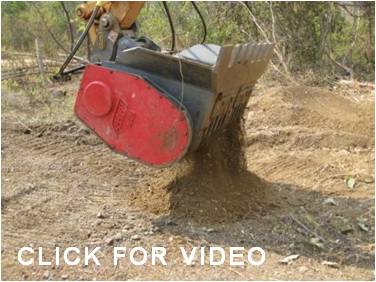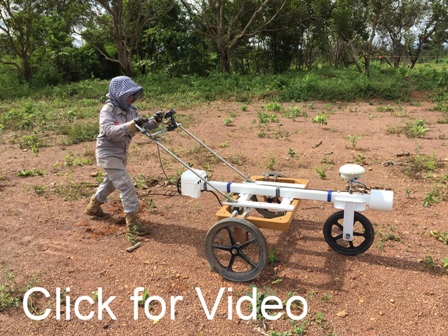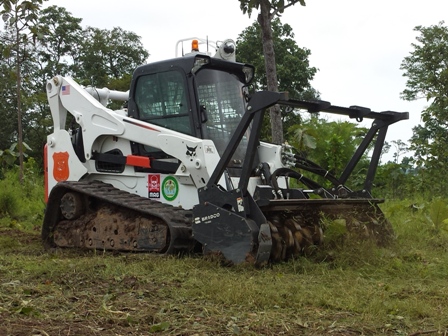





 |

The Socialist Republic of Vietnam is heavily contaminated by cluster munition remnants but the extent is not known. The United States dropped 413,130 tons of submunitions over Vietnam between 1965 and 1973, striking 55 provinces and cities, including Haiphong, Hanoi, Ho Chi Minh City, Hue, and Vinh. Vietnamís Military Engineering Command has recorded finding 15 types of US-made submunitions. Most submunition types used by the US were air-dropped, but artillery-delivered submunitions were also used in central Quang Binh and provinces to the south of it. The border with China is also contaminated with UXO and landmines.
The Military Engineering Command says it has encountered substantial amounts of abandoned cluster munitions, notably at or around old US air bases, including eight underground bunkers found in 2009, one reportedly covering an area of 4,000m2 and containing some 25 tons of munitions.
Vietnam`s mine problem is small compared with its other explosive remnants of war (ERW) contamination but the extent is unknown. Most mines were left by conflicts in the 1970s with neighboring Cambodia and China and affect areas close to its borders with those countries.
Vietnam cleared an area up to 1km deep along its northern border under an agreement with China, but areas further inland from the border are still contaminated with mines emplaced by the military of both countries. Since 2004, military engineers have reportedly cleared around 95km2 of contaminated land in the northern provinces of Cao Bang, Ha Giang, Lai Chau, Lang Son, and Quang Ninh bordering China under a project known as "Programme 120," destroying mainly Type 72, K58, and PPM-2 antipersonnel mines.
The US Humanitarian Demining Research and Development (HD R&D) Program deployed two area preparation tools and one soil sifting tool to Vietnam with the Mines Advisory Group (MAG) in 2011. Recently, the program deployed the Scorpion UXO Detection System and the Bearcat Area Preparation System with the Norwegian Peopleís Aid in September 2019. They have cleared a combined total of 5,979 items of unexploded ordnance (UXO) from 1,247,425 square meters through October 2020.
Sources: To Walk the Earth in Safety, 2023
Landmine Monitor Report, 2020
|
|
Multi-tool Attachments |

|
The Humanitarian Demining Research and Development (HD R&D) Program has developed a wide variety of excavator and loader based tools for mechanical mine clearance. These attachments give deminers the capability to perform area preparation, technical survey and mine clearance from a safe area. Tools that have proven useful include vegetation cutters, grapples, tillers, and buckets for sifting, grinding, and crushing. The HD R&D Program has modified several small, medium and large class excavators with armor protection and the interfaces needed to use these tools in various demining environments. Operational Field Evaluations (OFE) can be performed with HD R&D Program developed excavators or loaders, or with just the tools mounted to the demining organization`s own host equipment.
Distribution Statement A: Approved for public release.



PARTNERS: Mines Advisory Group; Golden West Humanitarian Foundation; The HALO Trust
|
|
Scorpion |

|
Scorpion is a man-portable unexploded ordnance (UXO) detection system that utilizes a one meter wide electro-magnetic induction (EMI) sensor and a total field magnetometer to detect buried UXO objects in an overpass mode. The system uses differential global positioning system (DGPS) to provide centimeter accuracy of target locations and mapping capability.
Distribution Statement A: Approved for public release.



PARTNERS: Golden West Humanitarian Foundation - Cambodia 2012; Mines Advisory Group - Cambodia; Norwegian People`s Aid - Vietnam, The HALO Trust - Afghanistan, Kosovo
|
|
Bearcat |

|
The Bearcat is a remote controlled, skid-steer chassis integrated with a vegetation cutter and a remote monitoring system for operation in suspect mine and UXO contaminated areas. Bearcat utilizes a completely commercial-off-the-shelf (COTS), plug-and-play, remote control system, and is designed for a wide range of area preparation tasks. The system allows demining and battle area clearance teams to quickly and efficiently remove vegetation for follow-on manual clearance teams. Distribution Statement A: Approved for public release.


PARTNERS: Mines Advisory Group - Cambodia; The HALO Trust - Colombia; Norwegian People`s Aid - Vietnam
|
|
    
|
|

